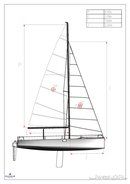Drakkar 24
Sailboat specifications
The Drakkar 24 is a 23’ (7m) multiple crew sport keel boat designed by Felci Yachts (Italy). She was built between 2015 and 2018 by Dufour (France).
Drakkar 24's main features
- Model
- Drakkar 24
- Hull type
- Monohull
- Category
- Multiple crew sport keel boat
- Sailboat builder
- Sailboat designer
- Country
- France
- Construction
- GRP (glass reinforced polyester):
- Hull: Single skin fiberglass polyester
- Deck: fiberglass epoxy (injection molding process) - First built hull
- 2015
- Last built hull
- 2018
- Appendages
- Lifting keel : swing keel
- Helm
- Single tiller
- Rudder
- Single transom hung rudder
- Unsinkable
- No
- Trailerable
- Yes
- EC design categoryiThe CE design category indicates the ability to cope with certain weather conditions (the sailboat is designed for these conditions)
A: Wind < force 9, Waves < 10m
B: Wind < force 8, Waves < 8m
C: Wind < force 6, Waves < 4m
D: Wind < force 4, Waves < 0,5m - C
- Standard public price ex. VAT (indicative only)
- About28 000 €(2017)
Drakkar 24's main dimensions
- Hull length
- 23’7 m
- Waterline length
- 22’ 1”6.75 m
- Beam (width)
- 8’ 4”2.54 m
- Draft
- 4’ 11”1.5 m
- Draft when appendages up
- 0’ 8”0.2 m
- Light displacement (MLC)
- 1918 lb870 kg
- Ballast weight
- 661 lb300 kg
Drakkar 24's rig and sails
- Upwind sail area
- 287 ft²26.7 m²
- Downwind sail area
- 635 ft²59 m²
- Mainsail area
- 161 ft²15 m²
- Genoa area
- 126 ft²11.7 m²
- Jib area
- 90 ft²8.4 m²
- Symmetric spinnaker area
- 398 ft²37 m²
- Gennaker area
- 474 ft²44 m²
- IiFore triangle height (from mast foot to fore stay top attachment)
- 24’ 11”7.6 m
- JiFore triangle base (from mast foot to bottom of forestay)
- 8’ 8”2.66 m
- PiMainsail hoist measurement (from tack to head)
- 26’ 7”8.1 m
- EiMainsail foot measurement (from tack to clew)
- 10’ 2”3.1 m
- Rigging type
- Sloop Marconi 9/10
- Mast configuration
- Deck stepped mast
- Rotating spars
- No
- Number of levels of spreaders
- 1
- Spreaders angle
- Swept-back
- Spars construction
- Aluminum spars
- Standing rigging
- 1x19 strand wire continuous
Drakkar 24's performances
- Upwind sail area to displacementiThe ratio sail area to displacement is obtained by dividing the sail area by the boat's displaced volume to the power two-thirds.
The ratio sail area to displacement can be used to compare the relative sail plan of different sailboats no matter what their size.
Upwind: under 18 the ratio indicates a cruise oriented sailboat with limited performances especially in light wind, while over 25 it indicates a fast sailboat. - 315 ft²/T29.3 m²/T
- Downwind sail area to displacementiThe ratio sail area to displacement is obtained by dividing the sail area by the boat's displaced volume to the power two-thirds.
The ratio sail area to displacement can be used to compare the relative sail plan of different sailboats no matter what their size. - 697 ft²/T64.74 m²/T
- Displacement-length ratio (DLR)iThe Displacement Length Ratio (DLR) is a figure that points out the boat's weight compared to its waterline length. The DLR is obtained by dividing the boat's displacement in tons by the cube of one one-hundredth of the waterline length (in feet).
The DLR can be used to compare the relative mass of different sailboats no matter what their length:
a DLR less than 180 is indicative of a really light sailboat (race boat made for planning), while a DLR greater than 300 is indicative of a heavy cruising sailboat. - 80
- Ballast ratioiThe Ballast ratio is an indicator of stability; it is obtained by dividing the boat's displacement by the mass of the ballast. Since the stability depends also of the hull shapes and the position of the center of gravity, only the boats with similar ballast arrangements and hull shapes should be compared.
The higher the ballast ratio is, the greater is the stability. - 34 %
- Critical hull speediAs a ship moves in the water, it creates standing waves that oppose its movement. This effect increases dramatically the resistance when the boat reaches a speed-length ratio (speed-length ratio is the ratio between the speed in knots and the square root of the waterline length in feet) of about 1.2 (corresponding to a Froude Number of 0.35) . This very sharp rise in resistance, between speed-length ratio of 1.2 to 1.5, is insurmountable for heavy sailboats and so becomes an apparent barrier. This leads to the concept of "hull speed".
The hull speed is obtained by multiplying the square root of the waterline length (in feet) by 1.34. - 6.31 knots
Drakkar 24's auxiliary engine
- Engine(s)
- 1 outboard engine
Drakkar 24's accommodations and layout
- Cockpit
- Open aft cockpit
Similar sailboats that may interest you:
Sailboats
First built hull
Hull length
2004
24’ 4”7.4 m
1982
23’ 4”7.1 m
2015
24’ 7”7.5 m
2015
24’ 7”7.5 m
2015
20’ 10”6.34 m
2015
20’ 10”6.34 m
2018
26’ 2”7.99 m
1993
24’7.32 m
2016
22’6.7 m
2018
20’ 10”6.34 m
1983
22’ 6”6.85 m
2012
22’ 8”6.93 m
2012
23’ 4”7.09 m
2006
24’7.32 m
2012
26’ 2”7.99 m









